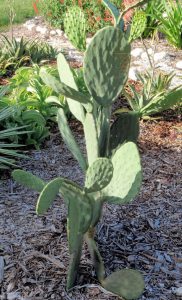
Did you know that we have a native prickly pear cactus here in Florida? This low-growing species has attractive yellow flowers and forms a spreading clump. Prickly pears or Opuntia, such as our native prickly pear, are classic cacti found native to the New World. In addition to cultivated ornamental oddities suitable for succulent gardens, some types are even used and grown commercially for food. Prickly pears can offer both “pain and delight”!
All Opuntia, ranging from one to twenty-feet in height, are similar in form – generally round to oval, flat to cylindrical connecting pads studded with spines and smaller glochids. Especially beware the glochids – particularly irritating tiny spines that can imbed tenaciously to both your cloths and skin. On the opposite end of the spectrum, some types of Opuntia are spineless or nearly so. Beyond the attractive structural pads which make up the plant, gorgeous spring flowers in red, yellow, orange or pink are an added welcome feature. These are in turn followed by colorful edible fruits in shades of red, yellow and orange. These berries are up to three inches long and mature in summer. They have their own set of tiny irritating glochid spines that must be gingerly prepared. Peeling the skin off the fruit reveals sweet tart flesh with plenty of seeds. Special low-spine varieties are grown specifically for the production of nopales and used as vegetable.
Prick pears do best in sunny sites with well-drained sandy soil. They are well-adapted to alkaline soils and even tolerate coastal conditions and rock garden habitats. However, if they are in a low area where water accumulates after a rain, they will most likely rot out in short order. While used mostly as a unique specimen, Opuntia may be purposely placed as a protective barrier that no one will want to cross. Handled carefully with heavy gloves or padded tools made from rolled-up newspapers, these cactus can be moved and planted with relative safety. Propagation is as easy as simply taking pads removed from the mother plant. Allow these pieces to dry and callus off at the cut end. Propagate in moist sand for easy and rapid rooting.
One of the few pests that your prickly pear may encountered is a certain caterpillar that only feeds on prickly pear cactus. Appropriately named the Cactoblastus moth, these orange and black spotted caterpillars bore in and hollow out cactus pads. Secondary rots set in and destroy the pads. The only control is to remove the infested pads (which may contain numerous caterpillars) and destroy them. On the flip side, this Argentinian moth has been used as a biocontrol in some countries where Opuntia cacti are an invasive pest. Be assured that prickly pear cactus are not an invasive problem here as per the UF/IFAS Assessment of Non-native Plants in Florida’s Natural Areas…
Read full article: https://blogs.ifas.ufl.edu/charlotteco/2022/06/16/prickly-pears-pain-and-delight/
Resources:
Gilman, E. F. (2014) OPUNTIA SPP. PRICKLY PEAR CACTUS. The University of Florida Extension Service, IFAS.
UF/IFAS Gardening Solutions (2018) Prickly Pear. The University of Florida Extension Service, IFAS.
Habeck, D. H., Bennett, F. D. & Miller, C. (2016) Cactus Moth, Cactoblastis cactorum (Berg) (Insecta: Lepidoptera: Pyralidae). The University of Florida Extension Service, IFAS.
Pricklypear cactus (2016) Florida Wildflower Foundation. https://www.flawildflowers.org/flower-friday-opuntia-humifusa/ .
Source: UF/IFAS Alert – https://blogs.ifas.ufl.edu/



